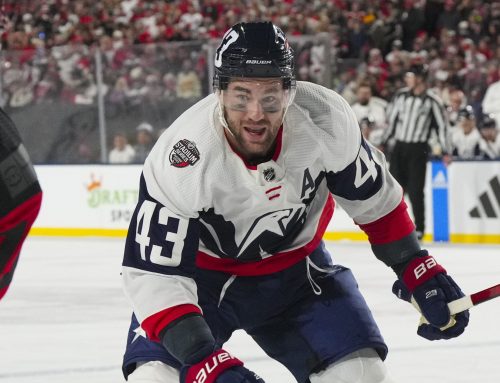Capped: The Importance of Cap Space in Making Trades
Scott Maran
2016-01-07

Salary cap space is quickly becoming an important advantage and a tremendous asset in the NHL trade market.
In today’s NHL, trades are as important as ever in building championship rosters. One only has to look to the Dallas Stars as proof. General Manager Jim Nill acquired Tyler Seguin, Jason Spezza, Patrick Sharp, and Alex Goligoski through trades and all these players play a crucial role on his team that currently sits in first place in the entire league.
And where would the Los Angeles Kings be if they didn’t trade for Jeff Carter and Mike Richards? Maybe they could have won a Cup in the future without Richards but Carter is an essential player to the team and there’s a good chance the Kings would have never been able to succeed without Carter’s play on the second line behind Kopitar.
The importance of trading players and assets to further benefit ones roster is undeniable. However, the act of carrying out these trades is quickly changing. Salary cap space has become a vital factor to a successful trade and heavily affects a teams bargaining position.
So what are some of the elements and factors in a trade? Well first of all, the current situations of each team have to match. A team that's contending for a playoff spot is more likely to make a trade with a team that's rebuilding than a team that is also hunting for a playoff spot. Also, the needs and assets of each team have to work well together. You can bet a team that has a poor group of defenseman isn't going to trade their top defenseman to a team that already has one of the best bluelines. But now, in the salary cap era of the NHL, a new element to the trade is evolving. A team's salary cap can be a very fragile thing; one trade can completely obliterate any room a team had under the maximum amount of money they could spend. Because of the salary cap, salary cap space is a luxury and has become another asset that a team can sell to other teams.
However, as valuable an asset salary cap space can be, there aren’t many teams that can fully utilize it. When one looks at the current salary cap landscape in the NHL, it can best be described as bleak. One-fifth of the NHL’s 30 teams have less than one million dollars in cap space and half of all the teams have less than three million dollars in cap space. Having so little cap space can severely restrict a team’s options and available moves.
For example, let’s say that a team like the Boston Bruins wants to add a top line player. They might need someone to slide into their top six and will be able to produce. They set their sights on Eric Staal and have potential assets that the Carolina Hurricanes would want. But how could the Bruins fit Staal under the salary cap? As of now, the Bruins have about one million dollars of cap space while Eric Staal carries an eight-million-dollar cap hit. It would almost be an impossible task to fit an eight-million-dollar contract on their roster. Maybe they could try to trade for a player that only carries a three or four million dollar contract, but he would bring significantly less value and less scoring to the team.
Even though salary cap space can become a problem in trades, what makes it an asset? Just look at the previous scenario and see it from the Hurricane’s view. A team having a lot of cap space can use this to their advantage and strengthen their bargaining position and drive up their price. Let’s say the Bruins really wanted Staal. To fit him under the cap, the Hurricanes retain half of his salary and accept one or two more players from the Bruins with high cap hits. Because the Hurricanes have helped out the Bruins by clearing so much cap space, the value for Staal would be that much higher.
Currently, two teams in the NHL hold an excess of 10 million dollars in salary cap space and 10 teams have at least five million dollars in cap space. These teams hold several advantages over the teams bound by the restraints of the salary cap. For instance, teams could retain salary on a high priced player, increasing the return on the player.
An example of this that comes to mind was a trade made last year by the Arizona Coyotes in a deal involving Keith Yandle, now a defenseman on the New York Rangers. Last year, the New York Rangers traded Anthony Duclair, John Moore, a first-round pick, and a second-round pick in exchange for Keith Yandle, Chris Summer, and a fourth-round pick.
Normally, the Rangers would be unable to implement this deal because they would exceed the maximum amount of salary they’re allowed to hold. But there was another detail in the trade. The Coyotes would retain 50% of Yandle’s salary, reducing his cap hit to a much more manageable $2.625 million. While Yandle would not normally be worth the Ranger’s top prospect, a decent prospect, a first-round and second-round pick, now Yandle’s contract also has tremendous value. The Rangers weren’t paying for just Yandle; they were paying for a first pairing defenseman with a very cheap contract. This ultimately drove up the price for Yandle because the Coyotes had enough cap space where they could retain the maximum amount of salary that the CBA allows.
Also, teams with an abundance of salary cap space can take back terrible contracts in trades. In a potential deal, a team could receive a player with a high cap hit in order to get a better return. For instance, last year during the NHL draft, the Ottawa Senators traded goalie Robin Lehner to the Buffalo Sabres. The Sabres only had to give the Senators a first-round pick in return in the trade because the Sabres also acquires another player, David Legwand. By also receiving Legwand and his three-million-dollar cap hit in the deal, the Sabres were able to get Lehner for a cheaper price. During the time of this deal, adding Legwand’s salary wasn’t a big deal for the Sabres because they had a lot of cap space and weren’t competitive. They were able use their salary cap space and turn it into a cheaper price for Lehner. This tactic has been used many times in trades like when Anaheim traded William Karlsson, a second-round pick, and Rene Bourque for James Wisniewski and a third-round pick or when Nashville traded Brendan Leipsic, a first-round pick, and Olli Jokinen for Cody Franson and Mike Santorelli.
In today’s NHL, salary cap space has rapidly become one of the most important components of a team. Year after year it seems to be growing in significance and it has heavily affected the trade market. Salary cap space is an important asset and a powerful advantage a team wields in the NHL trade market and it may even become more important in the future.
One Comment
Leave A Comment
You must be logged in to post a comment.





 TOR
TOR BOS
BOS DAL
DAL VGK
VGK EDM
EDM L.A
L.A COL
COL FLA
FLA T.B
T.B VAN
VAN WPG
WPG NYR
NYR

By the same token, for a team in contention, cap space is a constrained resource that should be used to the fullest if you are trying to win. It's great to have some space for flexibility, but if I fall short of a championship and have $5M of cap space that I could have used to obtain a player that would have put me over the top, I'm not doing the most effective job as GM.